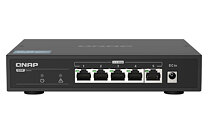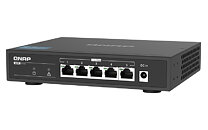Thursday, July 16th 2020

QNAP Introduces its First 2.5GbE Network Switch
QNAP Systems, Inc., a leading computing, networking and storage solution innovator, today launched its first 2.5 GbE network switch - the QSW-1105-5T. Featuring five 2.5 GbE ports, plug-and-play set up, automatic loop detection and blocking, and auto-negotiation functions, the QSW-1105-5T allows users to easily build a 2.5 GbE network environment for their home or business.
"For those looking to upgrade their network environment, the QSW-1105-5T 2.5 GbE strikes a balance between performance and cost. Users can instantly upgrade their network environment to 2.5 GbE using existing network cables, allowing them to take advantage of next-generation 2.5 GbE NAS and computers," said Frank Liao, Product Manager of QNAP.The QSW-1105-5T features five 2.5GbE/NBASE-T RJ45 ports that support 2.5G/ 1G/ 100M transfer speeds. With no complex settings required, the QSW-1105-5T supports auto-negotiation that optimizes transfer speeds and performance for each connected device, while its built-in management mechanism ensures smooth transmission of network packets. It also features network loop detection that can automatically lock looped ports to ensure the network environment quickly resumes normal operation.
The QSW-1105-5T features a fanless design for near-silent operation. The unique ventilated construction assists in cooling while maintaining high performance.
"For those looking to upgrade their network environment, the QSW-1105-5T 2.5 GbE strikes a balance between performance and cost. Users can instantly upgrade their network environment to 2.5 GbE using existing network cables, allowing them to take advantage of next-generation 2.5 GbE NAS and computers," said Frank Liao, Product Manager of QNAP.The QSW-1105-5T features five 2.5GbE/NBASE-T RJ45 ports that support 2.5G/ 1G/ 100M transfer speeds. With no complex settings required, the QSW-1105-5T supports auto-negotiation that optimizes transfer speeds and performance for each connected device, while its built-in management mechanism ensures smooth transmission of network packets. It also features network loop detection that can automatically lock looped ports to ensure the network environment quickly resumes normal operation.
The QSW-1105-5T features a fanless design for near-silent operation. The unique ventilated construction assists in cooling while maintaining high performance.



24 Comments on QNAP Introduces its First 2.5GbE Network Switch
2.5g isn't exactly next-gen tech IMHO, seeins how it's been around for several years now but laying dormant waiting on more mobo & NIC mfgr's to get off their lazy asses and bring it to the mainstream market...
Also why do the switch/router mfgr's insist on saying that these things have 5 ports, when in fact one of them has to be used for the incoming connection ? kinda deceptive if you ask me ....
Because they are five full duplex ports. If you connect 5 PCs they will be able to communicate with each other provided one of them acts as a DHCP server or if you have static IPs manually set. If you mean for WAN/internet connectivity then surely you have to use one of them for the router/modem.
24h.pchome.com.tw/prod/DRAFE2-A900AOQULThe thing is, 2.5Gbps Ethernet controllers are priced nearly at the same level as 1Gbps Ethernet controllers and are physically very similar in terms of size. 5Gbps and 10Gbps controllers, no so much. The latter also produce a lot more heat, whereas 2.5Gbps controllers use about as much power and produce about as much heat as a 1Gbps controller. Oh and 2.5Gbps uses Cat 5e up to 100m, whereas even 5Gbps can only run over Cat 5e up to 55m, but I guess for most home users that won't matter much.
With SSD in our computers 10Gbit home network should be the next natural step.
10Gbit is real OLD tech now so 2.5Gbit is ridiculous.
Hear people say that there is no demand for 10Gbit BUT THEY ARE WRONG.
People said the same thing about cpu cores when Intel insisted to only do max 4 cores for mainstream, there is no demand for more cpu cores.
Then AMD came with up to 16 cpu cores for main stream and the market just exploded.
If 10Gbit became standard on medium to high end motherboards the accessories market would just explode with massive upgrades with everything from NAS, nic cabels and all kind of network equipment.
10Gbps has never been as cheap as it is now per card, but that doesn't mean it has mass consumer appeal.
Not saying that 2.5Gbps does either, but it doesn't really add any cost to motherboards at least.
I still stand by having a separate USB 3.2 Gen 2(x2) "dongle" that can saturate the 10/20 Gbps purported bandwidth though. At least I would be able to move it from system to system if need be.
Most of us here are power users, or at least above the average consumer. If you use your computer for anything productive or a lot of gaming, you need proper networking. Most power users have some kind of NAS or file server, it doesn't take a lot before network speed becomes an annoyance.
But I wouldn't care what's included on motherboards if only 10G add-in cards and switches were affordable. The first time I considered investing in 10G equipment is seriously 10 years ago, prices haven't moved that much.
I should point out that he's one of the PMs.
The best alternatives I've seen so far is;
Asus XG-U2008 ($250) 2x 10G + 10x 1G
Netgear GS110MX ($170) 2x 10G + 10x 1G
Netgear XS505M ($350) 4x 10G
Netgear XS508M ($627) 8x 10G
(All US prices just for reference)
So what QNAP need to do is make a 2.5G router/switch wifi, because nobody wants to add an additional box to their loop just for 2.5G. Someone has to do it, might as well be QNAP since people wanting faster LAN speeds in their homes are likely to want them for NAS reasons.
Firstly, I don't think most people mind an extra box if it provides something useful. Most people do already use multiple boxes, since the bundled Wifi/router/switches are usually crap anyway. And even if there is a built-in switch, it is probably 4 LAN ports, 1 will probably be used for another access point in a better spot, 1 for "TV", and then you have just 2 left.
Personally, my issue with ISP provided equpiment and general consumer grade stuff is lack of standardization of physical dimensions and mounting options. Most of these are impossible to stack, and can't be rackmounted normally. The best option is often to screw them in a rack shelf or use velcro tape.
I've been supporting WFH staff for the last three months and out of several hundred people, not a single one of them has had a separate modem when being asked to restart their modem/router for troubleshooting (Just because the routers are OK doesn't mean the ISPs are any good).
I included 2-box since I know that's a thing that used to happen regularly here over a decade ago and it sounds like that is still very much a normal thing in the US.
Sorry, but you have no idea what you're talking about here.
I have a 10 port switch (2x 10Gbps), a router, a cable modem (technically a Wi-Fi/router/modem, but set to modem only mode, as it's crap as a router) and two Wi-Fi access points.
So yes, people are willing to have more than one box. I wish I didn't have the cable modem, but hey, it's how I get my internet...
Also also need Wi-Fi on each floor, despite the physical floor space not being that big, the three story house I live in, is built with a lot of concrete and rebar, which means Wi-Fi penetration is crap.
QNAP doesn't make routers and thank god for that, as their NAS software is full of security issues as it is.The UK is also behind most of the world when it comes to internet connectivity and what it costs. I mean, most of the UK is still stuck using ADSL2+ after all...
Yes, most ISPs (that provide hardware) have one box solutions, but it's not suitable for everyone. Also, how much control do you have over your BT box? Zero? Less than zero?
Most ISPs use this to connect remotely to your router.
en.wikipedia.org/wiki/TR-069
Some ISPs even have simple backdoor admin logins, there was a huge scandal a few years back in Sweden about this. I doubt it's all that different in other countries where the ISPs support the equipment.
I don't trust my ISP to have a remote connection into my home, but each to their own I guess.
I'm a bit curious about 10 Gb/s though, if I were to try that out I would at least check for packet loss and stability. Upgrading to Cat 6/6A is cheap compared to 10 Gb/s network cards and switches, so someone investing that much might want to upgrade cables too. The only negative is the work effort involved.
But regardless, anyone installing/buying new cables should go Cat 6A, even if they don't plan to use 10 Gb/s for another 5 years. The extra cost is negligible, so why not?
Don't get me wrong, the UK's rollout of true FTTP fibre is pitiful, but at least the overwhelming majority of the UK is getting 20-50Mbps or so and the better-late-than-never initiatives to subsidise FTTP investment from the last few years are starting to pay off. The UK will be behind for good now, but at least it's not that far behind....
The UK really bet too heavily on xDSL based technology, much like Australia.
Last time I lived in the UK I paid something stupid for a BT 100Mbps fibre connection and 200Mbps was twice what I was paying.
Anything below 100Mbps can't really be considered decent broadband these days, especially not if the connection is meant for multiple users.
Was stuck in Sweden for a few months and the service changed at my step mums place, but she has 250/100Mbps now for something like £32 a month...
That price doesn't include free hardware though, so I had to get her a router, but as everything is wired with Ethernet, no modem was needed.
I pay something like £22 a month for a 200/30 connection, as I'm stuck with a cable provider as my only sensible option.
I agree that "broadband" implies a wide pipe - wider than that absolute minimum typical application - and with streaming video using up maybe 4-5MB per user, PC and console gaming being in the gigabytes per install, and cloud-based applications requiring large uploads/downloads on a regular basis - 20Mbps should be considered narrowband.
Edit:
Too bad this switch doesn’t have a 10GbE uplink port but it’s not bad for the price IMO. Still, if 2.5GbE has the same energy efficiency as 1GbE and costs roughly the same then this switch is a bit overpriced. I mean a typical 4 or 5 port unmanaged 1GbE Switch would not cost ~$100 USD. You can get an 8 port unmanaged switch for under ~$40 USD.
www.amazon.com/MikroTik-CRS305-1G-4S-Gigabit-Ethernet-RouterOS/dp/B07LFKGP1L/ref=sr_1_3?dchild=1&keywords=CRS305-1G-4S%2BIN&qid=1599618360&sr=8-3
I have been using this for some time, while pretty warm it runs fanless and quietly.
For ~ double the price, you get 4 times higher speed. And in fact, the 10 Gbps parts (NIC) and adapters are too expensive;
I got 5x Intel X520-DA2 for $40 USD each two years ago, and the Intel optical adapters are around $10 each, all genuine parts bought from eBay.
Then fibers are cheap.
Honestly to me 2.5 Gbps looks weird given 10 Gbps isn't much more expensive.